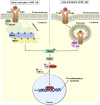Intestinal barrier permeability: the influence of gut microbiota, nutrition, and exercise
- PMID: 39040079
- PMCID: PMC11260943
- DOI: 10.3389/fphys.2024.1380713
Intestinal barrier permeability: the influence of gut microbiota, nutrition, and exercise
Abstract
The intestinal wall is a selectively permeable barrier between the content of the intestinal lumen and the internal environment of the body. Disturbances of intestinal wall permeability can potentially lead to unwanted activation of the enteric immune system due to excessive contact with gut microbiota and its components, and the development of endotoxemia, when the level of bacterial lipopolysaccharides increases in the blood, causing chronic low-intensity inflammation. In this review, the following aspects are covered: the structure of the intestinal wall barrier; the influence of the gut microbiota on the permeability of the intestinal wall via the regulation of functioning of tight junction proteins, synthesis/degradation of mucus and antioxidant effects; the molecular mechanisms of activation of the pro-inflammatory response caused by bacterial invasion through the TLR4-induced TIRAP/MyD88 and TRAM/TRIF signaling cascades; the influence of nutrition on intestinal permeability, and the influence of exercise with an emphasis on exercise-induced heat stress and hypoxia. Overall, this review provides some insight into how to prevent excessive intestinal barrier permeability and the associated inflammatory processes involved in many if not most pathologies. Some diets and physical exercise are supposed to be non-pharmacological approaches to maintain the integrity of intestinal barrier function and provide its efficient operation. However, at an early age, the increased intestinal permeability has a hormetic effect and contributes to the development of the immune system.
Keywords: HIF-1α; NF-κB; ROS; TLR4; inflammation; tight junction proteins.
Copyright © 2024 Dmytriv, Storey and Lushchak.
Conflict of interest statement
The authors declare that the research was conducted in the absence of any commercial or financial relationships that could be construed as a potential conflict of interest.
Figures




Similar articles
-
Pasture intake protects against commercial diet-induced lipopolysaccharide production facilitated by gut microbiota through activating intestinal alkaline phosphatase enzyme in meat geese.Front Immunol. 2022 Dec 8;13:1041070. doi: 10.3389/fimmu.2022.1041070. eCollection 2022. Front Immunol. 2022. PMID: 36569878 Free PMC article.
-
Qingrequzhuo capsule alleviated methionine and choline deficient diet-induced nonalcoholic steatohepatitis in mice through regulating gut microbiota, enhancing gut tight junction and inhibiting the activation of TLR4/NF-κB signaling pathway.Front Endocrinol (Lausanne). 2023 Jan 19;13:1106875. doi: 10.3389/fendo.2022.1106875. eCollection 2022. Front Endocrinol (Lausanne). 2023. PMID: 36743916 Free PMC article.
-
Effects of Si-Miao-Yong-An decoction on myocardial I/R rats by regulating gut microbiota to inhibit LPS-induced TLR4/NF-κB signaling pathway.BMC Complement Med Ther. 2023 Jun 2;23(1):180. doi: 10.1186/s12906-023-04013-9. BMC Complement Med Ther. 2023. PMID: 37268931 Free PMC article.
-
Negative Effects of a High-Fat Diet on Intestinal Permeability: A Review.Adv Nutr. 2020 Jan 1;11(1):77-91. doi: 10.1093/advances/nmz061. Adv Nutr. 2020. PMID: 31268137 Free PMC article. Review.
-
Exercise, intestinal barrier dysfunction and probiotic supplementation.Med Sport Sci. 2012;59:47-56. doi: 10.1159/000342169. Epub 2012 Oct 15. Med Sport Sci. 2012. PMID: 23075554 Review.
Cited by
-
Probiotic characteristics and whole genome sequencing of Pediococcus pentosaceus SNF15 and its protective effect on mice diarrhea induced by Escherichia coli K99.Front Vet Sci. 2025 Mar 13;12:1524658. doi: 10.3389/fvets.2025.1524658. eCollection 2025. Front Vet Sci. 2025. PMID: 40151573 Free PMC article.
-
Antioxidants in cancer therapy mitigating lipid peroxidation without compromising treatment through nanotechnology.Discov Nano. 2025 Apr 24;20(1):70. doi: 10.1186/s11671-025-04248-0. Discov Nano. 2025. PMID: 40272665 Free PMC article. Review.
-
Genomic Characterization and Functional Evaluation of Eurotium cristatum EC-520: Impacts on Colon Barrier Integrity, Gut Microbiota, and Metabolite Profile in Rats.Foods. 2025 Apr 29;14(9):1569. doi: 10.3390/foods14091569. Foods. 2025. PMID: 40361651 Free PMC article.
-
Blocking leukotriene receptors improve experimentally induced gastric ulcers in rats by inhibiting inflammation and apoptosis.Int J Immunopathol Pharmacol. 2025 Jan-Dec;39:3946320251351083. doi: 10.1177/03946320251351083. Epub 2025 Jun 21. Int J Immunopathol Pharmacol. 2025. PMID: 40542712 Free PMC article.
-
The Oral-Gut Microbiome-Brain Axis in Cognition.Microorganisms. 2025 Apr 3;13(4):814. doi: 10.3390/microorganisms13040814. Microorganisms. 2025. PMID: 40284650 Free PMC article. Review.
References
-
- Anderson R. C., Cookson A. L., McNabb W. C., Park Z., McCann M. J., Kelly W. J., et al. (2010). Lactobacillus plantarum MB452 enhances the function of the intestinal barrier by increasing the expression levels of genes involved in tight junction formation. BMC Microbiol. 10, 316. 10.1186/1471-2180-10-316 - DOI - PMC - PubMed
Publication types
LinkOut - more resources
Full Text Sources

